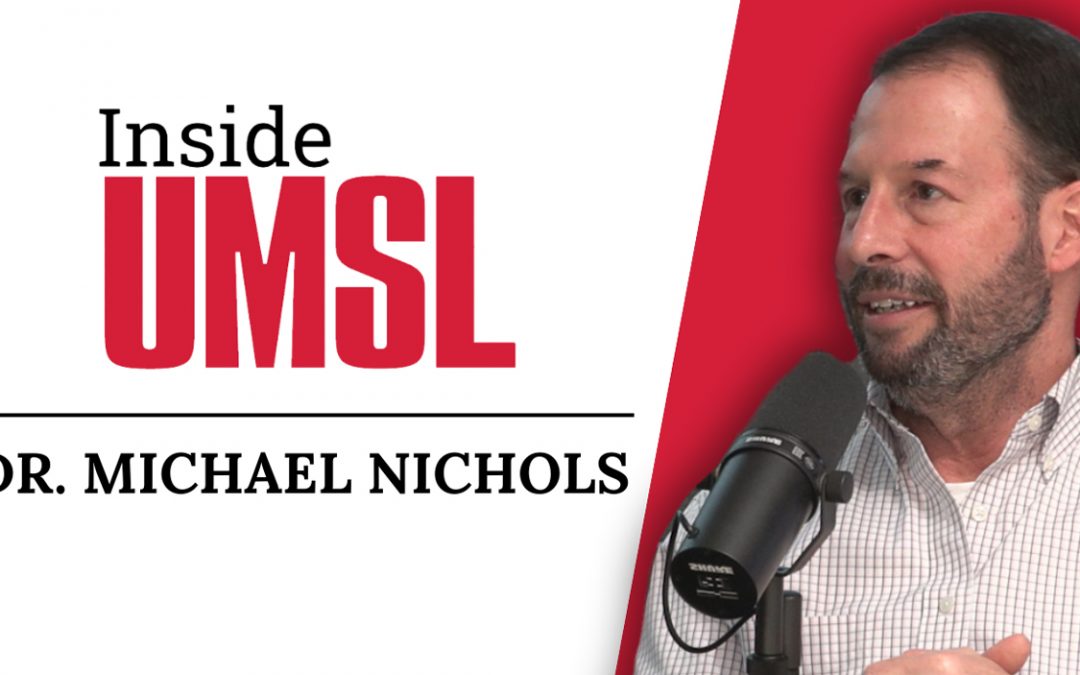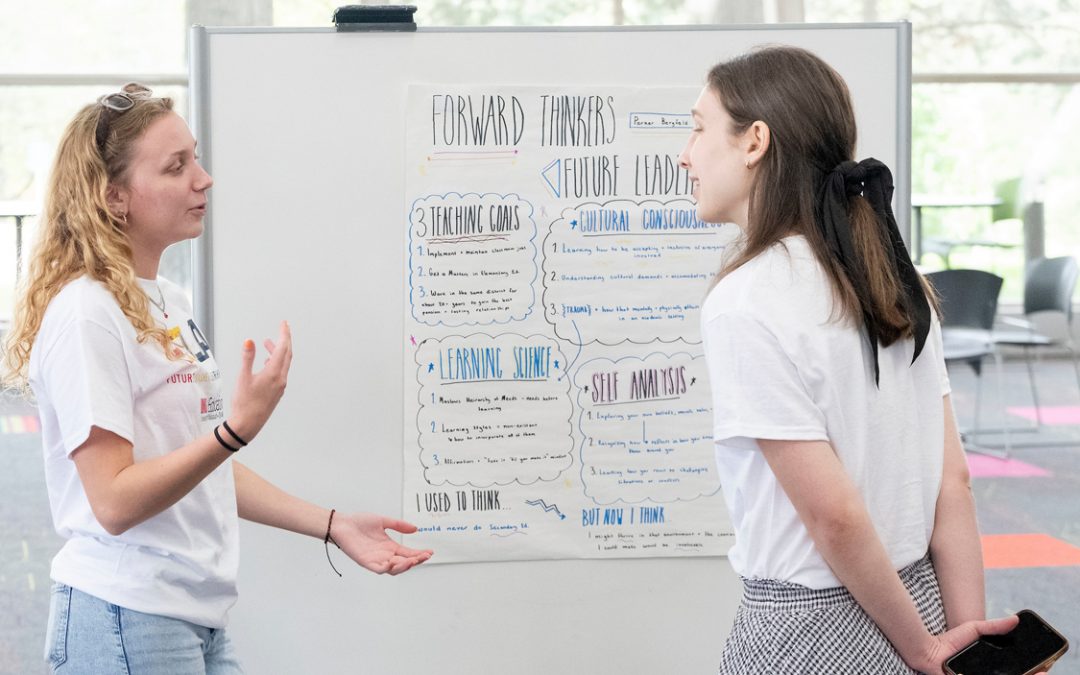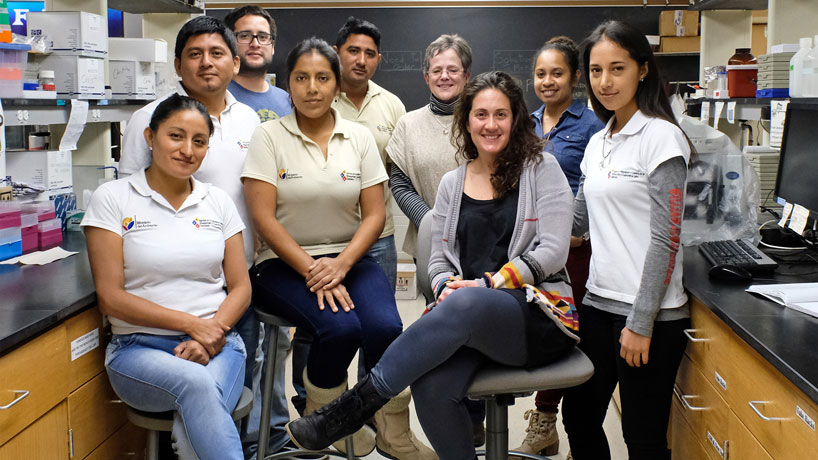
The UMSL and ABG Galápagos teams take a moment to gather around in Patty Parker’s lab at UMSL. Sitting (from left) are Rita Criollo, Paulina Castillo and Mari Jaramillo. Standing (from left) are Alberto Vélez, José Iturrizaga Shaw, Fabricio Vásquez, Parker, Samoa Asigau and Erika Guerrero Vásquez. (Photos by August Jennewein)
For a team of Ecuadorian lab technicians and veterinarians, visiting the U.S. was a first, as was their stepping out into a St. Louis snow-covered morning last week.
Believe it or not, their visit was for the sake of tropical ecology research happening on the Galápagos Islands.
The Galápagos, specifically the study of the ecology of that province of Ecuador, is one of the unexpected specialties of a lab in the Midwest and at the heart of the Department of Biology at the University of Missouri–St. Louis.
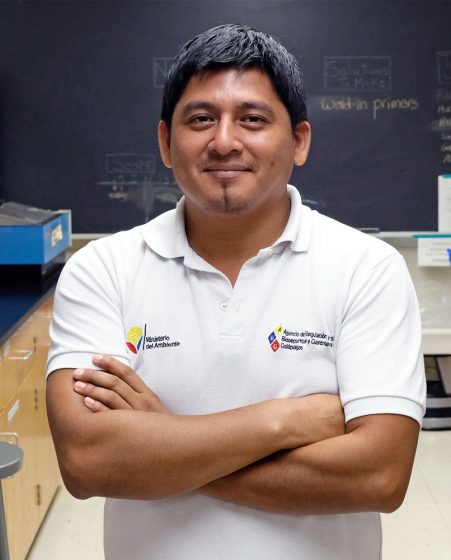
Alberto Vélez, lab manager for ABG’s quality control unit, is passionate about the work he’s doing to preserve the Galápagos Islands’ biodiversity and defend it against invasive species and disease.
E. Desmond Lee Professor of Zoological Studies Patricia Parker and her UMSL students have, for many years, conducted research on the islands, tracking the presence and transmission of avian malaria and other pathogens in native and nonnative birds. The research and travel is partially funded by the Saint Louis Zoo and the Whitney R. Harris World Ecology Center at UMSL. Parker is currently interim director for the center.
“We have sent research teams to Galápagos every year, at least once each year, and some years as many as three times, to work with in-country partners on disease surveillance research,” Parker said.
Samoa Asigau and Mari Jaramillo, Parker’s two trusty doctoral candidates studying avian malaria, have been among the beneficiaries of that partnership.
Last week UMSL and Parker’s team returned the favor. Agencia de Regulación Y Control de la Bioseguridad para Galápagos (Agency for Biosecurity in Galápagos) sent a team of five to learn and study lab protocols, techniques and methods used to test samples collected from animals.
ABG is an arm of the national Ministry of the Environment, so it has the support of the Ecuadorian government, not just the local Galápagos National Park. The locals have been dealt a federal mandate to understand and mitigate disease threats to the animals of the islands, both the domestic animals on the four human-inhabited islands and the populations of wild iconic Galápagos endemic species on all 16 islands.
“There’s a lack of trained staff in the Galápagos,” said Alberto Vélez, the lab manager for ABG’s quality control unit. “ABG is still relatively new, having been established in 2012, and is in the initial phases of obtaining materials, equipment and personnel. That’s the reason we’re here – to learn all that we can.”
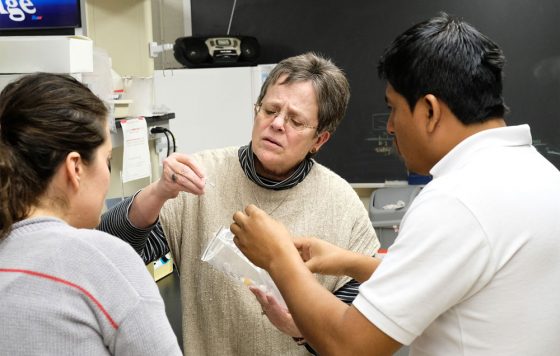
Mari Jaramillo (at left), Patty Parker (center) and Alberto Vélez examine one of the tick specimens Vélez brought with him from the Galápagos to further investigate the species of tick and whether it is responsible for the possible spread of disease among horses on the islands.
It’s a step in the right direction according to Parker, who said it’s been a longtime goal to build local capacity for disease surveillance.
What came in tote with Vélez? Ticks. Dead and in sample containers in a Ziploc bag, of course. Besides honing his lab techniques, Vélez hoped to get one step closer to answering if the ticks he brought are responsible for the spread of “piroplasmosis equina” or “Equine piroplasmosis” caused by protozoan parasites Babesia caballi. They’re suspicious the disease has been affecting horses on the islands.
“First we have to determine the tick species,” he said, “and then we have to determine if the same disease we find in the tick is the one we find in the horses.”
Using morphological measures and features, Vélez was able to determine that the ticks are from the genus Dermacentor, which could be of concern.
“The literature says that the bite of one of these ticks can also transmit a neurotoxin that could actually paralyze a person,” he said. “They know this for this specific genus, but it varies by species.”
DNA extraction and sampling will be used to confirm the genus and narrow in on the species.
But the learning and opportunities in St. Louis weren’t only in the lab. Parker also arranged for the ABG team to visit experts at one of the Harris Center’s key partners – the Saint Louis Zoo. There, the veterinarians of the ABG group got a chance to study the zoo’s veterinary hospital procedures and medical diagnostics, including a necropsy.
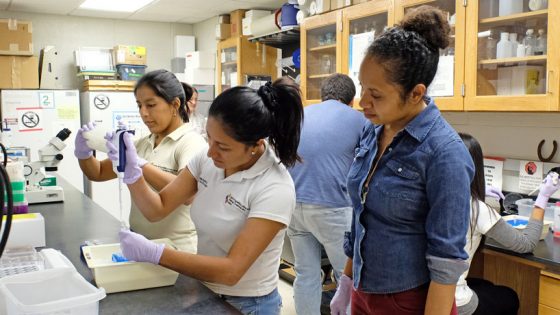
Rita Criollo (center) practices PCR (Polymerase Chain Reaction), a new skill for the ABG veterinarian, who is typically responsible for collecting samples from the animals but can now see herself filling in for a lab worker if necessary in the future. UMSL doctoral student Samoa Asigau (at right) observes as Criollo and Paulina Castillo (at left) practice the techniques Asigau has helped teach during the week.
“When the doctor opened the animal during the necropsy, she pressed the scalpel into the lungs and it absorbed air signifying a negative pressure inside, which means the animal hadn’t been breathing when it died,” said Rita Criollo, an ABG veterinarian. “That’s one thing that I didn’t consider before and hadn’t had the chance to encounter in the Galápagos.”
Back in the lab, Asigau and Jaramillo got to practice their teaching skills with the team.
“It’s been rewarding and eye-opening,” said Jaramillo, who is a native Ecuadorian. “They underestimate the level of training that they have. All that we are providing is small details that might have been overlooked maybe because doing this type of lab work is much harder in the conditions over there.
“I have learned from them a lot of things too,” she continued. “So I’m glad that we have that type of education in Ecuador. Alberto hasn’t had training outside of Ecuador, and he’s very knowledgeable, and that’s very rewarding for me as an Ecuadorian. And that he has the interest and the will and the passion to learn all these things and to connect with experts all over and learn from them is exciting, too.”
The ABG team will spend the rest of this week at the University of Missouri–Columbia visiting labs and farms.













